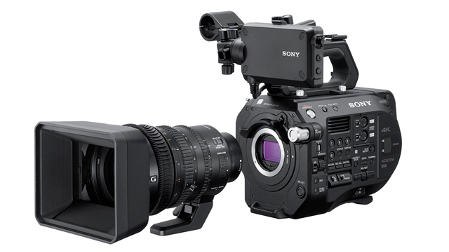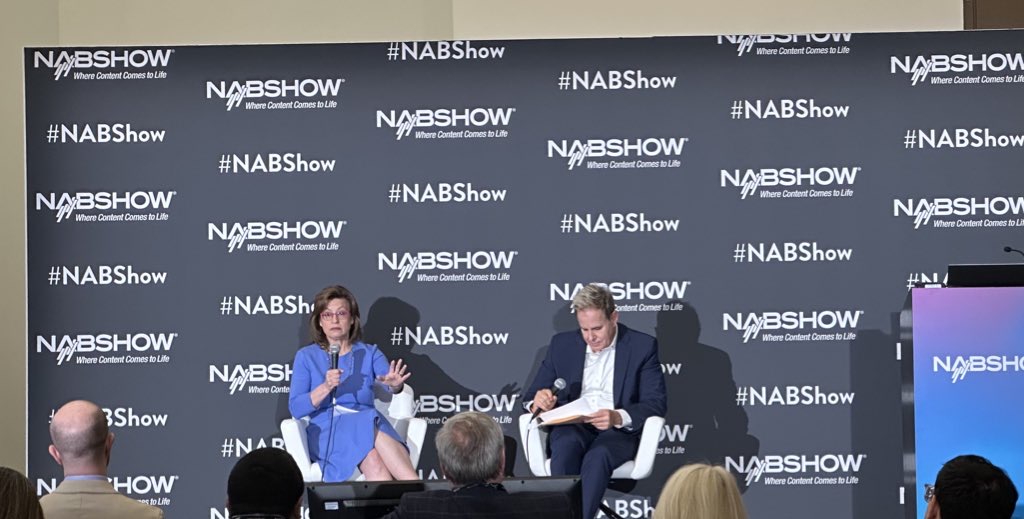Sony Debuts FS7 II at NAB Show NY
NEW YORK—At the NAB Show New York this week, Sony introduced the FS-7II, a new version of its popular PXW-FS7 Super35 4K camcorder, which it introduced a little more than two years ago. The PXW-FS7 has found itself used in everything from scripted drama to unscripted doc to corporate to web—to every application imaginable. Firmware has already reached version 4 with more updates promised.

The new FS7 II offers advanced features and improved ergonomics, which is positioned above the current FS7. Sony very carefully notes that the FS7 will remain in the current product lineup and will continue to receive firmware updates.
All of those features that have popularized the FS7 remain. The camera still shoots in internal XAVC codec, both I frame and LongGop versions, as well as legacy MPEG2. Full DCI-4K continues to be supported to the XQD cards and all Sony and third party accessories continue to work with the FS7 II.
There is no change in the actual body or the sensor. Improvements are seen in three key areas that we’ll detail as well as in color space, which will also merit some explanation.
ELECTRONIC VARIABLE ND FILTER
Electronic Variable ND filtration was introduced with the PXW-FS5 camera and it now migrates to the FS7 M II. The camera has a range of two to seven stops of ND attenuation and users have a choice of three ND modes to take advantage of that wide range.
Preset ND
The MII has the same four position ND turret as the original FS7, clear plus three presets. However in both the FS5 and FS7 II, users can select preset attenuation from the camera menu system and turning the dial changes the ND. Just like in the FS7 except users decide the presets.
Variable ND
A toggle on the side of the camera switches the camera side control wheel between Iris and ND. A Preset to Variable ND toggle sets ND to variable. No documentation needed to figure that one out. Then using either the camera side wheel or the front wheel on the camera’s control grip, ND can be dialed variably within the two to seven stop range in 1/4 stop increments. Changes do appear seamless, though. A major advantage here is the ability to set the desired f stop and then not touch lens aperture again. It is ideal for determining the depth of field desired and then adjust exposure by varying the amount of ND.
I’ve experimented with this feature and find it invaluable when shooting run and gun, for example, and wanting to maintain depth of field but finding wildly variable lighting.
Auto ND
Auto ND is today’s auto iris. Auto Iris, well, pros really shouldn’t use it. But Auto ND responds much more quickly than auto iris and once again a constant aperture maintains identical lens and DOF characteristics. Auto ND cannot be selected from any on-camera labeled controls. It needs to be assigned to one of the FS7 II’s 10 user assignable buttons. And a great hint for using it—set camera to Auto ND to get a ballpark exposure, then switch back to variable ND to fine tune exposure.
LEVER LOCK TYPE E MOUNT
The second major improvement is significant. The FS7 II has a locking mount very much like the PL mount system employed by many cinema cameras or available on the FS7 via third-party adapters. Simply rotate the mount and insert the lens straight-on. There is no twisting and turning of the lens bayonet. It fits just like a PL lens. Then rotate the mount counter clockwise until it clicks, engaging a secure locking mechanism. The lens cannot be disengaged accidentally owing to this lock, which must be released manually to disengage the lens. And all of this can be one one-handed.
This mount is sturdy enough to support many heavier lenses without support. I have tested this mount with a heavy Sony 28-135mm and the new Sony 18-110mm lens and have found no wobbling or play. This mount feels rock solid.
MECHANICAL and ERGONOMIC IMPROVEMENTS
Viewfinder
Many of us FS7 users have voiced complaints about the FS7 viewfinder mount and the eyepiece. Sony answered those concerns with a total redesign of the assembly. The viewfinder now has both a square and a round rod and is adjustable via knobs. The square knob ensures that the LCD screen will not tilt sideways. It can be adjusted along horizontal and vertical axes. Since the rods are standard 15mm, they may be used with any other 15mm rod. The LCD screen now has a pop-up shade. The eyepiece itself now attaches one-handed securely via a revamped clip system. As an added bonus, the eyepiece diopter is a standard 32mm diopter and may be changed by users.
Microphone Holder
The Microphone Holder is now also mounted via 15mm rod with clamps. Its position can be adjusted and the microphone holder and viewfinder can even be reversed.
Smart Grip
The SmartGrip is one of the greatest features of the FS7. It allows for camera balance and flexible shooting positions with its adjustable features and with the molded adjustable handgrip. The new SmartGrip can now be adjusted without tools and can even be mounted via ARRI rosette on camera to configure camera to shoot from the waist. Sony indicates that this revised grip will be available as a separate purchase in the future for FS7 users wishing to take advantage of its new rage of movement.
The operator’s side of the camera required some rearranging of controls to accommodate the variable ND feature and to add more user configurable buttons. The FS7 II now has seven user configurable buttons on the camera body and three on the handgrip.
Another frustration of FS7 users is the tight tolerance of the XQD cards. The XQD cards now protrude twice as far from their slots for easy insertion and removal, even while wearing gloves.
The audio control door has been moved away from the XQD slots. And here is my favorite—there is now a power-on LED. I’ve worn down more than one FS7 battery by not paying attention to camera power switch alone.
A NEW LENS FOR A NEW CAMERA
At IBC 2016, Sony introduced a new Super35/APS-C cinema lens, the 18-110mm G f/4 servo zoom. While it is compatible with all Sony motion and still E mount cameras, this is the lens that is available as an optional kit lens for the FS7 II.
The lens features superb G-series optics but again answers several concerns raised by the 28-135mm f/4 users. First of all, it is wider and that is no small feature. Most significant though is the ability to disconnect the servo zoom and have a full mechanical zoom with no servo lag for snap and manual zooms. The focus ring has no fly-by-wire feel in manual focus mode and rotates a full 240 degrees. It is geared to allow follow focus or motor drive.
A NEW COLOR GAMUT
Prepare for HDR acquisition and delivery. The FS7 II supports the new broadcast BT.2020 standard for recording and output via either HDMI or SDI.
A few words are essential here. BT.2020 is a broadcast spec. That means it only records up to QFHD (3840x2160). Obviously one must view the footage on a BT.2020 monitor. But BT.2020 is capable of the camera’s complete 14-stop dynamic range unlike BT.709.
BT.2020 gamut may be selected only in the camera’s Custom Mode. What far too many users do not grasp is that the FS7 and now the FS7 II are two cameras in one—a broadcast-standards camera (Custom Mode) and a cinema camera (CineEI). In CineEI mode, the shooting choices are SLog2, SLog3 or RAW (with optional XDCAFS7 back and compatible RAW recording system). Color gamuts range from SGamut3.cine, a narrower gamut for grading on available technology, or SGamut2 and SGamut3, much wider gamuts than can be displayed on any device. If shooting in this cine mode but wanting to deliver for HDR in a BT.2020 output gamut, then the wider SGamut2 or SGamut3 spaces will be converted in post.
CustomMode uses both standard and hypergammas with more extensive image control in camera. Shooting for broadcast HDR using a BT.2020 color gamut this is applicable in Custom Mode since the only other broadcast choice would be BT.709.
While most of us will not be using the BT.2020 space, it is good to know that it is present to protect our investments when we are shooting for HDR delivery.
The Sony PXW-FS7 II offers features more advanced than the PXW-FS7 while delivering the same image, meaning that the two cameras cut together seamlessly.
It is a worthy entry to the Sony line and affirms Sony’s commitment to this important market segment.
Sony PXW-FS7 II
www.pro.sony.com
Price: TBD body only
TBD with 18-110 Kit lens
Sony 18-110m f/4 lens: Standalone: $3495
4.5/5 diamonds
Pros: More advanced than FS7 with variable ND, locking E mount, improved set up and ergonomics and BT.2020 codec
Cons: Commands premium price over current FS7. No changes to FS7 in codecs, internal frame rates and sensor.
Overall: A worthy big sibling for the PXW-FS7. Lens locking system and VariableND features are significant improvements to the original camera while the new viewfinder mounting system makes LCD and eyepiece adjustment a one-handed snap.
Get the TV Tech Newsletter
The professional video industry's #1 source for news, trends and product and tech information. Sign up below.
